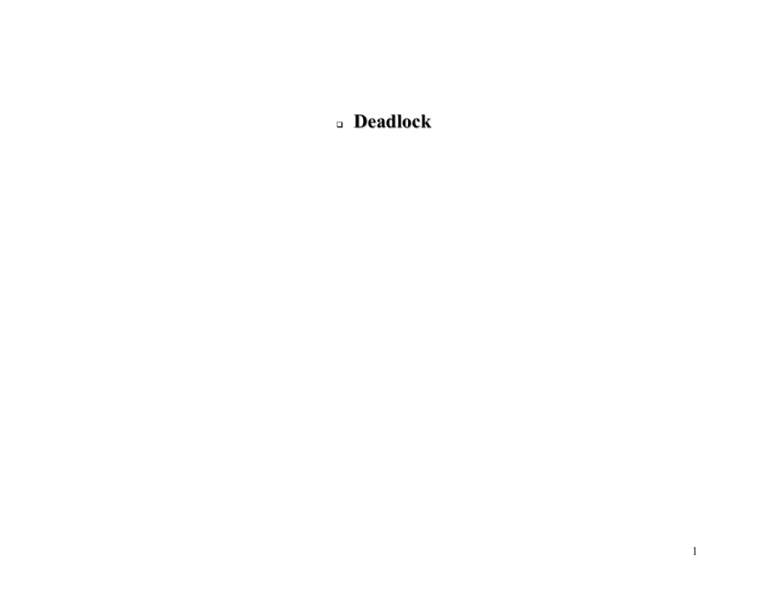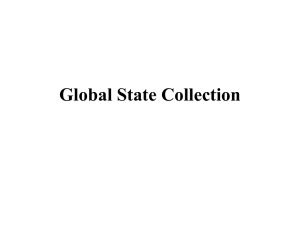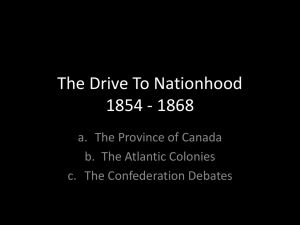Deadlock
advertisement

Deadlock 1 Deadlock Deadlock is the permanent blocking of a set of processes that either compete for system resources or communicate with each other. Deadlocked processes, while holding some resources, are requesting access to resources held by the other processes in the same set (circular wait). Deadlock in general defies an efficient solution. Wait-for-graph (WFG) For the purpose of characterization of deadlocks, a system state is commonly modeled by a WFG. The problem of Deadlock is common in computer systems where resource sharing is frequent. 2 Deadlock vs. Starvation Starvation Starvation occurs when a process waits for a resource that becomes available but is never assigned to that process. A deadlocked process is permanently blocked because the required resource never becomes available. In a starvation situation, it is never certain that the process will obtain the requested resource. However, it is possible for the starved process to obtain the requested resource sometime in the future. In a deadlock situation, the resource under contention is not under continuous use. In a starvation situation, the required resource is in continuous use and that is why the process is starved. Solutions for Starvation are easier than deadlock. Priority inversion, even counters. 3 Necessary Conditions for Deadlock Process requiring following four conditions: Exclusive access to a resource (Mutual Exclusion). Wait for additional resource/s while holding previously acquired one/s (Partial Allocation). A resource cannot be preempted from a process without aborting the process (Nonpreemption). Circular wait (Resource Waiting). 4 Deadlock Handling Policies: Deadlock prevention. Deadlock detection. Deadlock avoidance. 5 Models Models for requesting resources Single-Unit Request Model. - A cycle in the WFG is indicative of a deadlock in the system when there is only one unit of every resource in the system. AND Request Model. - A cycle in the WFG is indicative of at least a deadlock in the system again provided that there is only one copy of every resource in the system. - A process can be involved in more than one deadlock in this model. OR Request Model. - A cycle in the WFG is not a sufficient condition for a deadlock. - Presence of a knot in the WFG is a sufficient condition for a deadlock in this model. 6 AND-OR Request Model. - A knot in the WFG is a sufficient condition for a deadlock in this model. The P-out-of-Q Request Model. - AND request model when P = Q. - OR request model when P = 1. - Presence of a knot in the WFG is a sufficient condition for a deadlock in this model. 7 Models of resources. Types of resources. - Reusable resources. - Consumable resources. Types of resource accesses. - Exclusive ( In this course, for the study of deadlock, we will assume that all accesses are exclusive). - Shared. - Only applicable for reusable resources. 8 The General Resource Graph (GRG). Request edges (PI, Rj). - P is a process and R is a resource. Assignment edges (RI, Pj). Producer edges (RI, Pj). - Consumable resources. 9 Operations on the GRG. Request Acquisition Release 10 Necessary and Sufficient Conditions for Deadlock A blocked process is deadlocked if and only if (iff) there is no way for it to become unblocked. A process is not deadlocked iff we can find a sequence of operations that leave the process unblocked. Graph Reduction Method: For each process Pi For each and every resource Rj, delete all edges (Pi, Rj). If Rj is consumable, decrement rj by the number of deleted request edges. For each and every resource Rj, delete all edges (Rj, Pi). If Rj is reusable, increment rj by the number of deleted request edges. If Rj is consumable, set rj = . 11 P1 P1 R1 R2 R1 R2 P2 P2 P1 R1 R2 P2 12 A process PI blocked in state S, is not deadlocked in state S iff there exists a sequence of reductions in the corresponding graph that leaves PI unblocked. A sequence of reductions demonstrates the manner in which a blocked process PI may become a runnable process. If a blocked process is to become runnable, then some sequence of process execution must exist to unblock it. If a graph is completely reducible, then the state it represents is not deadlocked. 13 Reducibility may depend on the order of reduction. An algorithm for detecting deadlock may have to, inspect up to n! possible reduction sequences, where n is the number of processes. Worst-case time complexity is O(m*n!), where m is the number of resources. - Clearly, it is inferred that reducibility is not the basis for practical algorithms for deadlock detection. - In the following graph, based on the order of reductions, the outcome of reduction is different. P1, P2 order of reduction, produces a reducible state but P2, P1 does not. P1 R2 R1 P2 14 Some terminology. Expedient state: All processes having outstanding requests are blocked. Blocked: Waiting to be assigned a resource when sufficient units of that resource are not available. Reachable: A node y is reachable from a node x in a graph (xy), iff there is a path (sequence of directed edges) from node x to node y. Cycle: A cycle in a graph is a path that starts and ends in the same node. Sink: A node in a directed graph is a sink iff it has only incoming edges to it. Knot: A knot k in a graph is a nonempty set of nodes such that for every node x in K, all nodes in K and only the nodes in K are reachable from x. - Therefore, no node in a knot can be a sink. 15 A cycle is a necessary condition for a deadlock. If the graph is expedient, then a knot is a sufficient condition for a deadlock. The absence of a knot in a general resource graph does not imply the absence of a deadlock in the corresponding system state since a knot is not a necessary condition for deadlock. 16 Systems with Single-unit Requests A process can only request one resource unit at a time. Thus a general resource graph of such a system can contain only one outgoing edge from a process node. An expedient general resource graph with single-unit requests represents a deadlock state iff it contains a knot. This suggests an efficient method for the detection of deadlocks for singleunit request systems. 17 Systems with Only Reusable Resources For this type of systems, all reduction sequences give the same final outcome. S is not a deadlock state iff S is completely reducible. Therefore, in reusable resource systems, if a resource graph cannot be completely reduced, then the corresponding system state is deadlocked. In single-unit resource systems, since there is only a single unit of every resource, then a cycle in an expedient resource graph is a necessary and sufficient condition for a deadlock. 18 Deadlock Detection Requesting processes are given resources without any checks of the future system state. Periodically, the system state is checked for deadlock. Based on the type of system, checks for a knot, cycle or even graph reduction method is used to determine the state of the system. Deadlocks are resolved by aborting one or more of the processes involved. 19 Deadlock Prevention Requesting processes are given resources in a way such that the request does not lead to deadlock. Must insure that one of the four conditions necessary for deadlock never occurs. One solution is for each process to acquire all needed resources. This eliminates the partial allocation condition. Implementing process preemption is another solution. 20 Deadlock avoidance. A process is granted it’s required resources only if it is safe. Maximum resource requirement of each process is known at every point during its execution. Banker’s algorithm is an example of a deadlock avoidance algorithm. 21







